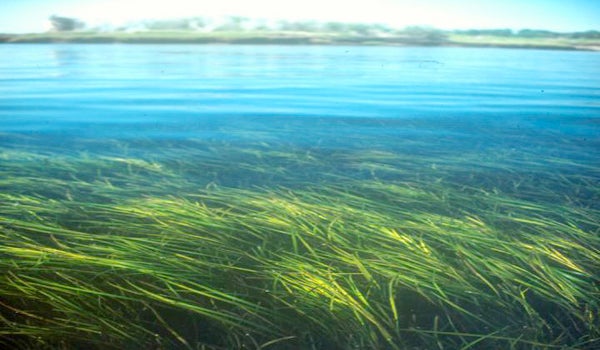Aquatic grasses good for Pamlico River and its tributaries
Published 11:24 am Monday, June 1, 2015

VIRGINIA INSTITUTE OF MARINE STUDIES | CONTRIBUTED
NEW HOME: Beds of saltwater eel grass such as this are re-appearing in the lower Pamlico Sound area. This is an extremely good omen for both commercial and sport fishermen.
Fishermen along the Pamlico River and several creeks leading into the lower Pamlico River were really encouraged back in late April and early May to see lots of widgeon grass (Rupia sp.) growing in the shallow waters of the estuary.
Sport fishermen occasionally curse at this grass because it snags in their fishing lines, but most who understand the importance of this aquatic plant realize that the appearance of this grass is an indication of good health for marine organisms.
Our Albemarle and Pamlico Estuarine area is extremely valuable to the ecology of the entire mid-Atlantic coastline, serving as a nursery area for numerous species of fish and shellfish. This “nursery area” usually has an abundance of both shallow water and rooted aquatic vegetation that supplies hiding areas for juvenile fish and shellfish.
Outdoorsmen familiar with the Pamlico River will remember when the shallow water along the shorelines was covered in dense mats of widgeon grass. The grass-line ended when the abrupt drop-off into deeper water became too deep for the sunlight to get to where the widgeon grass grew, and it was along this grass-line that numerous predatory fishes such as speckled trout, red drum, striped bass and even largemouth bass looked to find minnows, blue crabs and shrimp.
At one time, this grass-line along the shore of Durham Creek near where the Potash Corporation production plant and mine now stands was a highly productive place to catch largemouth bass. Waterfowl hunters knew that good summer’s growth of this grass meant good hunting in the fall.
After the early, encouraging signs of the widgeon grass that was rooted and growing well returning to the lower Pamlico River area, it was pretty discouraging to recently see mats of widgeon grass broken loose from the bottom and floating away on the water. The water was about the color of weak coffee with cream in it. It was now impossible for the sunlight to penetrate the water to where the widgeon grass was growing.
No one seems to know just what is causing this discoloration of the water along South Creek and the lower Pamlico River, but this does not bode well for the highly important aquatic grass.
Commercial and recreational fishermen are finding that the trout and red drum fishing is nearly non-existent in this questionable section of the Pamlico Estuary. Sport fishermen that are known to be good anglers recently spent two days casting for trout and drum around Indian island and reported that they did not have even one strike for two days effort.
With the poor fishing reports coming from the “dingy water” section of the Pamlico, we decided to give the fishing a try out into the eastern side of the Pamlico Sound and found the water’s color there seemed to be clear. Taking the boat into the shallow bays looking for fish signs, we found some abundant aquatic grass of a different kind.
Years ago, the eel grass in this part of the sound had disappeared, but now vast beds of this highly desirable grass were everywhere. Whenever you find conditions like this (clear water, lots of vegetation and “corn-cob” mullets jumping everywhere), it’s a good bet that there will be good drum, flounder and trout fishing there. In a couple of hours, four slot-limit-size redfish were taken and released. Hooray for the good eel grass beds we found.
The Virginia Institute of Marine Studies (VIMS) is doing a lot of work trying to re-establish the eel grass beds that had about disappeared from the Chesapeake Bay and they’re seeing a good amount of success for their efforts. I hope that North Carolina will have similar success in re-establishing eel grass in the eastern part of the Pamlico Sound.
Wee returned to the same area of the eastern part of the sound early the next morning hoping to duplicate the good luck we had the previous afternoon. The first thing we saw when we slowly entered the large bay was a commercial netter fishing his nets where we’d taken the red drum the day before. We watched him pull his nets for a couple of hours and he appeared to have a good catch of flounder, drum and trout.
The area is a large area and there should have been enough fish left to satisfy us sport anglers, as well as the commercial netter, but our efforts with casting gear and artificial lures produced no fish that morning. Maybe the netter just spooked the larger fish from the area or maybe we just didn’t use the right lures or methods. That’s fishing.
I’m just glad to see the eel grass returning to the area. That means good fishing for the rest of the summer and holds a lot of promise for the duck hunting this fall and winter. Let’s hope that the water clears up where South Creek joins the Pamlico River and the widgeon grass re-appears there in time for the fall fishing and hunting.





